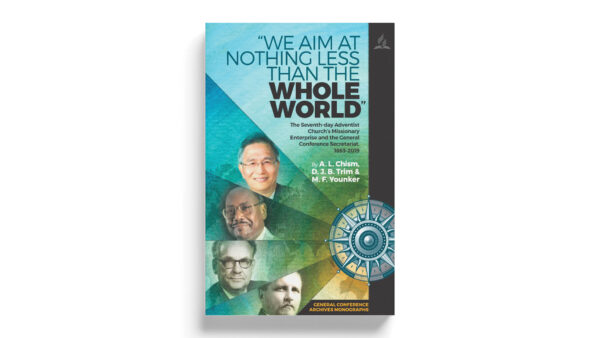By the end of 2022 the world population is expected to reach the staggering number of 8 billion people. Reaching the whole world with the gospel of Jesus is, humanly speaking, an ambitious and impossible task, but even more so when considering that the Seventh-day Adventist Church (SDAC) has a relatively small membership of about 22 million. In “We Aim at Nothing Less Than the Whole World” the three authors look at the history of the Secretariat missionary enterprise and the General Conference (GC) between 1863 and 2019 by assessing decisions and actions taken.
The book is likely the most accurate picture of the General Conference history during the past 150 years in terms of cross-cultural mission to the world. It is based on solid statistical assessment with a balanced understanding of hidden aspects that most people would generally disregard when looking at the raw data.
One of the reasons for the book was to assess “whether the current priorities of the International Service Employee program are the same as of makers of the Adventist Church’s missionary-sending program a century and more ago” (p. xvii). The authors offer valuable historic information that shows progress and trends, but, most important, some real challenges pointing to evidence that “in recent years priorities have changed” (p. xvii) that the church must confront if it wants to reach the unreached with greater results.
The book is organized in two parts. Part One provides a historical overview of the missionary enterprise with statistics to help the reader recognize trends and patterns. It defines what a missionary is and the role of the administrative structure. It also suggests that with growth come challenges, such as the “medicalization” and bureaucratization. Part Two focuses on the history of the mission structure of the GC Secretariat. Chapter Seven analyzes the trends during the past 70 years, highlighting that with the growth and geographical expansion of organized church work and its demand for greater oversight, the number of missionaries declined significantly. Furthermore, insufficient time was left to plan for and to promote mission.
Billions still haven’t heard the good news of the salvation in Jesus Christ. The church, as the authors point out, “is not yet even close to a victory lap. . . . This book is a call to action—more pointedly, an urgent call to change course and to embrace many elements of an earlier mission-focused vision” (p. 248). Despite tremendous growth during the past century, “both the actual number of cross-cultural missionaries engaged in mission to unreached peoples, and the proportion of church membership that they represent, have fallen precipitously” (ibid.).
The book calls for the urgent implementation of less bureaucratic systems, structures, and processes that will foster innovation and will reignite a passion for cross-cultural mission. This will be possible only by intentional action of the organization, under the guidance of the Holy Spirit. An example of these possibilities was the creation of I Will Go—a bottom-up movement led by students of Universidad Adventista del Plata in Argentina. As a result of this mission awakening, hundreds of students and volunteers have been sent to many countries to serve in many projects and unentered areas.
A picture speaks a thousand words, and this book is, in my view, the best picture of the church’s missionary enterprise. It should be read by all administrators, missionaries, teachers, students, and those interested in cross-cultural mission. It’s both an evaluation of what the church did right and what needs to be changed, revised, or improved.



